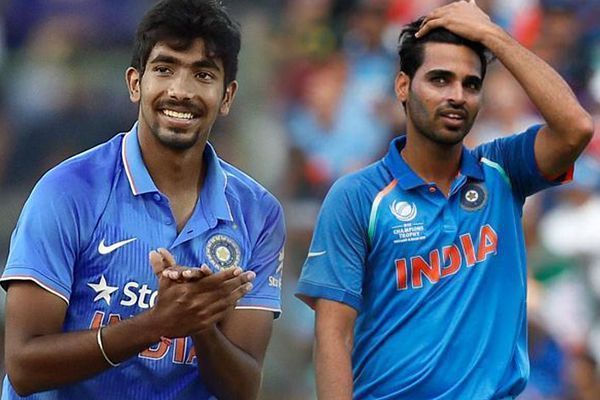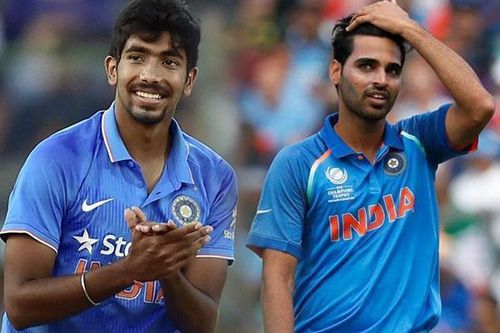
Analysing the rise of the Indian pacers prior to the 2019 World Cup

For a country which is generally known for producing batting maestros and spin wizards, fast bowling has generally taken a back seat in Indian cricket. It is in the very DNA of every die-hard Indians fanatic to be a batsmen first and then roll over an arm. Unlike the West Indians, Australians and South Africansm who have tasted heavy success in both forms of cricket owing to their never ending seam bowling arsenal , Indian cricket has generally crafted their match winning strategies around their formidable batting line-ups and potent spin attacks. However one facet which has been a chink in their armory and hampered their performances while touring abroad was lack of a formidable pace attack.
India had its share of fast bowlers, some of whom were the best in their eras but never had a formidable pace attack. Post India’s heroics in the 1983 World Cup, the late 80s and early 90s saw Kapil Dev and Manoj Prabhakar take on much of the fast bowling load on their shoulders. While the legendary Kapil with his rhythmic run up and beautiful action was a lethal out-swing bowler, Prabhakar was a crafty bowler with his deceptive slower ones and yorkers.
Chetan Sharma bowled some terrific spells in England but that last ball Miandad six at Sharjah sent him into permanent oblivion. Meanwhile, all-rounders Roger Binny and Madan Lal did a decent job but in honesty were limited in their skills. So the 'Men in Blue' just had an above average seam attack largely inspired by Kapil Dev’s bowling efforts on the green turf.
In the mid and late 90s, Javagal Srinath and Ventakesh Prasad formed a handy pace duo in ODIs but dint have the requisite bench strength to back them up. Srinath in particular was India’s best new ball seamer who bowled with pace and got good movement off the deck. His tall and lanky Karnataka state mate Venkatesh Prasad was quite handy on the bouncy tracks of South Africa and England. ‘Venki’ was also one of the best exponents of leg cutters.
However, there was a dearth of world class bowlers besides the Karnataka duo. The likes of Debashish Mohanty, Abey Kuruvilla, Harvinder Singh, and Dodda Ganesh who were proven wicket takers in the domestic circuit could not quite find their feet in international cricket. Although Ajit Agarkar made an explosive start to his ODI career picking up heaps of wickets, his flashes of brilliance were negated by inconsistencies in his performances.
At the turn of the new millennium, a plethora of youngsters emerged as the future of Indian bowling. Zaheer Khan looked the most promising of the lot and gradually became the spearhead of the Indian bowling post Srinath’s swansong. ‘Zak’ who started off as a tearaway pacer eventually developed into one of the best exponents of seam bowling. Ashish Nehra bowled some match winning spells but his frail physique and poor fitness levels were exposed by constant injuries.
Munaf Patel and VRV Singh’s raw pace excited everyone but they eventually lost their steam and settled into line and length bowlers. Irfan Pathan looked to blow away attacks with his lethal swing and made gigantic leaps but unfortunately the team management's forced on decision to make him an all-rounder took a toll on a promising bowling career. In the interim, medium pacer Praveen Kumar did a good job as a wicket taking bowler in the limited overs arena. However he too fell trap to disciplinary problems and faded after couple of good seasons.
Lakshmipathy Balaji would have certainly been one to watch out for if a recurrent back injury would have not ended his career abruptly. The tall and lanky Ishant Sharma made sporadic appearances in blue clothing as he was always dubbed more a Test specialist. Indian cricket was desperately looking to some to turnaround their fast bowling fortunes. In the last five odd years, we have seen the emergence and rise of a quality Indian fast bowling attack which has a plethora of world class seamers.
The current Indian seam attack rubs horns with the best in the world. The pace attack has a lot of variety in its armory with speed merchants who can rattle oppositions and bowlers who can swing the ball like a banana. Speedster Umesh Yadav is as quick as anyone and can consistently bowl in the 140 mph region. Bhuvneshwar Kumar is lethal with his swinging deliveries on seam friendly tracks and Jasprit Bumrah has tremendous control with both the new and old ball.
Bumrah and Bhuvneshwar Kumar have become a formidable new ball attack in ODI cricket making inroads into the best of batting line-ups. Then there is Mohammad Shami who can extract seam movement by landing the ball in the right areas. Never ever in our ODI cricketing history, we had four quality seamers operating in the same era. Hardik Pandya has come up as a handy medium pacer and fits into his role as a support seamer to perfection. Besides these four, you have a promising bench strength with Siddharth Kaul, Shardul Thakur, and Mohammad Siraj who have done enough in domestic cricket to knock on the selector’s doors. Meanwhile the fast bowling seems to be brimming with exciting prospects like Kamlesh Nagarkotti and Shivam Mavi, who have showcased their prowess at the ICC Under 19 World Cup and the 2018 Indian Premier League.
Indian cricket has reached lofty heights under the captaincy of both MS Dhoni and Virat Kohli and much of their stellar run in white ball cricket has been largely attributed to a well-rounded pace attack, lethal both at home and overseas conditions. With the 2019 ICC Cricket World Cup not far away, India certainly have the luxury of fielding one of the best pace attacks in seam friendly English conditions.